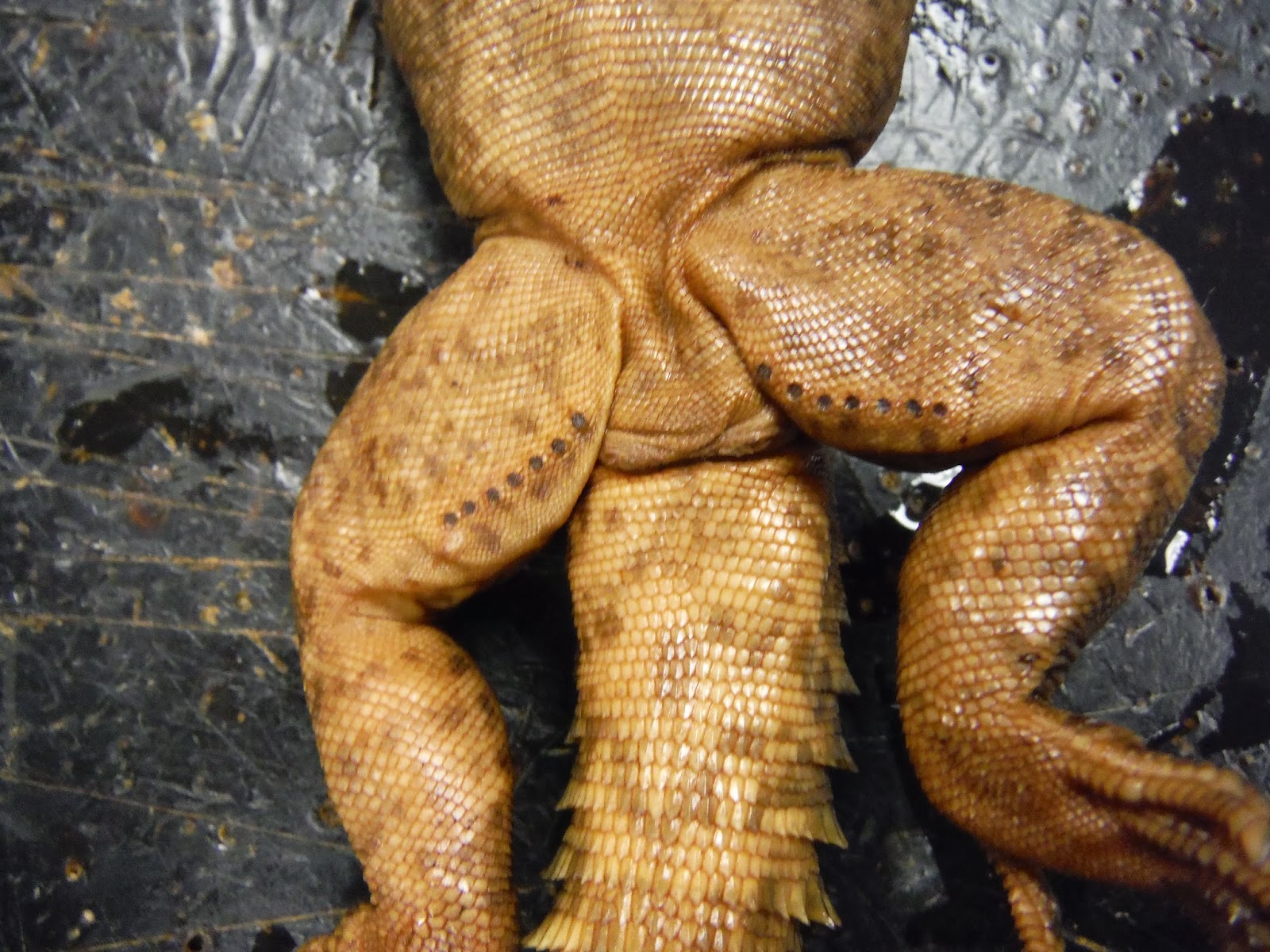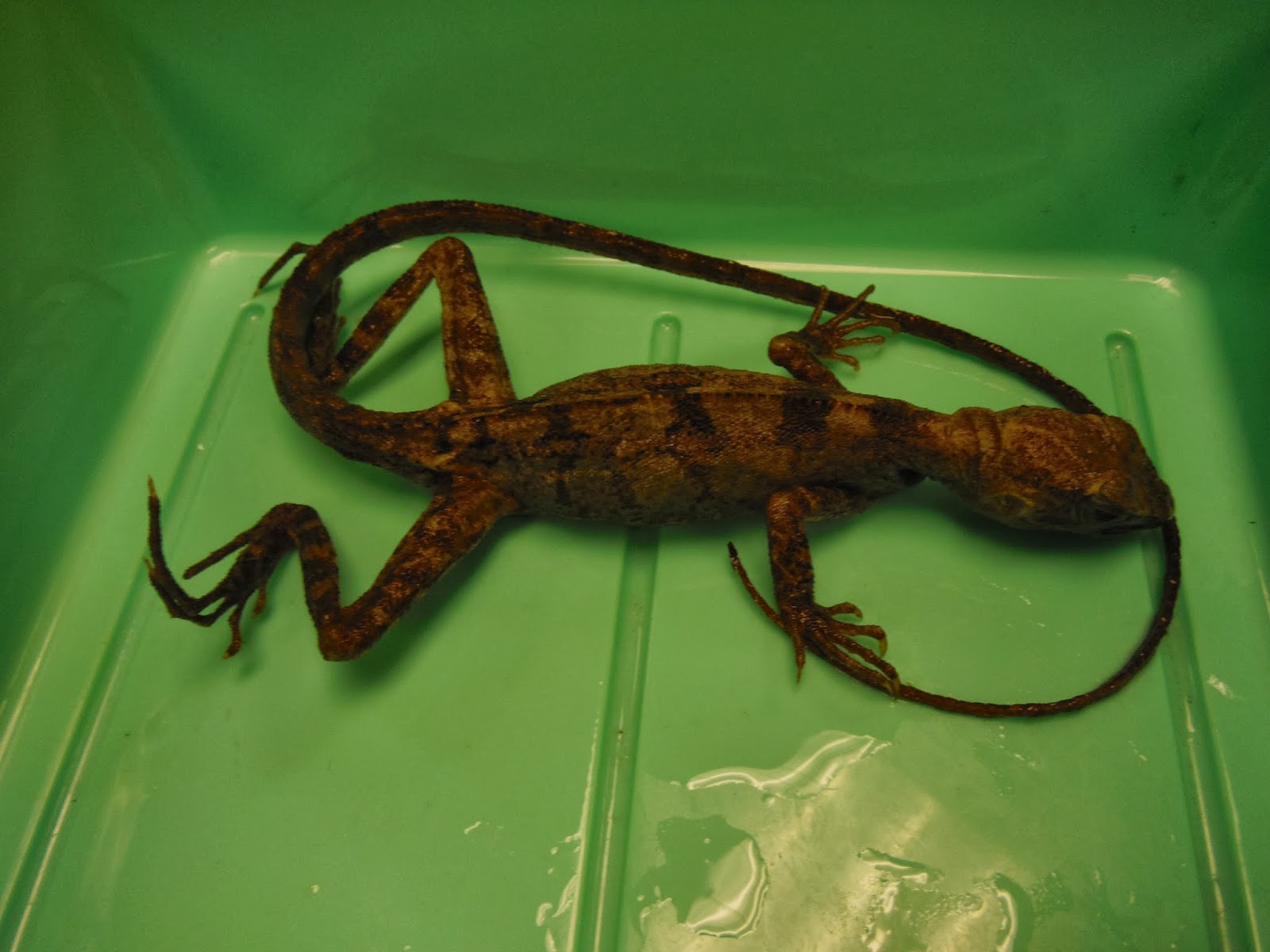 |
| Lizard families within Sauria, specimens from underlined families were investigated in lab. |
Introduction
There are two sister lineages within Eureptilia,
Archosauromorpha (Lab 3 & 4) and Lepidosauromorpha.
Lepidosauria synapomorphies:
1) Transverse cloacal aperture (vent)
1) Transverse cloacal aperture (vent)
2)
Notched tongue
3)
Full body ecdysis
4)
Imperforate columella (stapes)
5)
Teeth are attached to the jaws
6)
Pelvic bones fused in adults
7)
Fracture planes or septa within caudal vertebrae
Within Lepidosauria are the
Sphenodontida, made up of extant Tuatara & Rhynchocephalians; and the
Squamata, made up of Sauria (lizards) and Serpentes (snakes).
Squamata is a very numerous and
diverse group of reptiles. It consists of over 8,000 species that are found on
every continent in the world (except Antarctica) and on most sub tropical and
tropical islands. Because these reptiles are so widely spread throughout the
world, they have each developed their own unique behaviors and characteristics
to adapt to environments that are either hot or cold, wet or dry, freshwater or
saltwater, etc.
Squamata synapomorphies:
1) Fused
premaxillae
2) Fused
parietals
3) Reduced
nasals
4) Lack
of vomerine teeth
5) Specialized
joints between ulna-ulnare and radius-radiale
6) Specialized
ankle joints
7) Well
developed hemipenes
8) Saccular
ovaries
9) Jacobson’s
organ separated from nasal capsule.
10) Lacrimal
duct joining the vomeronasal duct
11) Femoral
and pre-anal glands
12) Egg
tooth at hatching
Phylogeny & Diversity
The history of lizard systematics is a very controversial topic. Many argue over how large the families of the
clade are, how inclusive family-level groups should be, whether or not to
elevate some sub-families into families (for instance the subfamilies of
Iguanidae), etc. As a result hypotheses
have been presented based on molecular, morphological, and behavioral evidence
and many different arrangements of the reptilian clade have been put forth. As of now, at least 19 families have been
recognized, but there may be as many as 36.
“From an evolutionary perspective,
it shouldn’t matter whether we recognize a group as a sub family or family, so
long as we understand that the clades are real and that the relationships among
them are real”For Step 1 during lab, the anatomy of the skull in Varanus was observed. A handout was provided by Dr. Sheil which the dorsal, ventral, and lateral views for this genus. Observe the figure below and note the particular bones associated within each of the three views. This figure is for the species Varanus griseus.
 |
| See which bones you can identify on this varanid lizard skull. |
Lizard Families
We should note that there are many families of lizards for the squamates. Although not all of these families were covered in lab, Step 2 examines the following families of lizards that were present in lab. For each family, make sure that you take note of the distribution along with some of their distinct characteristics which are presented below.
Agamidae
 |
| Draco volans, a gliding agamid |
Anguidae
(Looks like a snake when limbless, but this anguid is not a snake!)
 |
| Do you see the eyelids on this limbless Ophisaurus? |
Characteristics: These lizards can either be limbed or limbless which have tails that can be twice the length of their body. All of them are heavily armored with largely nonoverlapping scales and contain osteoderms on the trunk dorsally and ventrally. Ventrolateral folds are well developed in most anguidswhich allows for body expansion for breathing, feeding, and reproduction. The tongue bears papillae and lacks lingual scales which are associated near the tongue. The skull can have present or absent squamosals along with a fused parietal; the parietal perforates the parietal foramen. They possess pleurodont dentition.
 |
| Note the acrodont teeth in this chameleon |
Characteristics:
Chameleons are unique for their laterally compressed bodies, prehensile tails,
head casques covering their necks, and Xygodactylous feet where sets of digits
are fused forming opposable fore-and hind feet. All of these species are limbed
where the specialized pectoral girdle lacks an interclavicle and clavicles.
Their tails are moderately short to long and the tongue is covered with
reticular papillae dorsally.
Gekkota
 |
| An example of a eublepharid gecko |
Sphaerodactylidae:
Known as the dwarf geckos, they possess well-developed limbs along with tiny
juxtaposed scales. Adults are no larger than 60mm SVL Their eye is covered by a spectacle cover and do not possess
eyelids.
 |
| One member of Sphaerodactylidae (top) and two members of Gekkonidae (middle and bottom) |
Distribution:
Southwestern North America
 |
| Skull cast displaying pleurodont dentition and synostotic fusion of dermal bones to skull |
These lizards have been historically grouped into one large family named Iguanidae. This clade has recently been elevated to Pleurodonta and the historical subfamilies have been elevated to family level.
Inguanidae (prev. Iguaninae): In their skull, the lacrimal foramen is not enlarged, the jugal and squamosal are not in broad contact, Meckel’s cartilage in the mandible is fused. To determine sex, note that males possess femoral pores where the females do not.
Distribution:
Americas from southwestern United States to south Brazil, West Indies, and
west-central Pacific islands
 |
| Femoral pores on male iguanid |
Corytophanidae: These lizards have pterygoid teeth, but no palatine teeth. Males have no femoral pores and adults are usually 90-200mm SVL.
Distribution: Southern Mexico to Northern South America
 |
| The long toes on the hind limb of this Basciliscus enable it to run on water. |
Dactyloidae: This is the most speciose family within Pleurodonta, most species range between 40-80mm SVL. Males lack femoral pores and are usually larger than females.
Distribution: Southeastern US through Central South America and throughout West Indies
Scincidae
Characteristics: The skinks are always covered with overlapping scales dorsally and ventrally. They can either possess limbs or be limbless externally. Their interclavicle is absent, so the clavicles are angular. Their tails are moderately long; tongue bears papillae; pleurodont dentition.
Characteristics: This family of whiptail lizards, tegus, and allies are small to large lizards that possess smaller scales on the dorsal and lateral views of the body compared to the ventral view. All of the species within this family have well-developed limbs along with a long, autonomous tail. The posterior edges of the lingual scales are smooth; teiids possess pleurodont dentition.
 |
| Two teiid lizards (top and middle) compared to a varanid lizard (bottom) |
Characteristics: Family of the Kamoto Dragon (Varanus), most are moderate to large in size with thick skin containing numerous rows small scales circling the body. Their ventral scales are slightly larger than the dorsal scales. Varanids possess pleurdont dentition and a hemibaculum, a cartilaginous strut in each hemipenis.
Ohio Diversity
Family: Phrynosomatidae
Sceloporous undulates garmani (Northern Fence Lizard)Family: Scincidae (skinks)
Scincella lateralis (Ground Skink)
Plestiodon fasciatus (Five-Lined Skink)
Plestiodon laticeps
(Broad-Headed Skink)
Plestiodon anthracinus (Northern Coal Skink)
















No comments:
Post a Comment